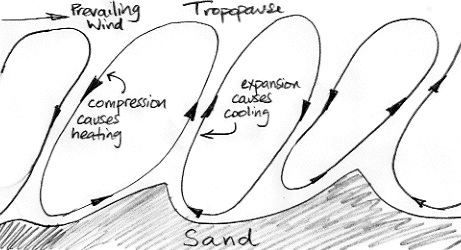The air above the desert cools by 20°C at night. But the heat capacity of the air above the desert is so great that it is impossible for it to cool so quickly by radiation into space or by conduction to the ground. We ended our previous post with the suggestion that the drop in temperature over the desert at night is caused not by the cooling of air, but by the replacement of warm air by cold air.
In Biggles Flies South, the author tells us that flying over the desert during the day is exhausting and uncomfortable because the air is so "bumpy". The best time to fly is the early morning, when the air is still and there is daylight to see by. Our understanding of atmospheric convection suggests that the air above the desert will be a succession of convection cycles, something like the drawing below, where small features of the surface end up dictating the boundaries of the cycles, and the cycles are angled sideways by a prevailing wind.

All this convection is caused by the sun heating the desert sand until it warms the air and causes the air to rise. But when the sun goes down, the sand cools off quickly. The circulation will eventually come to a stop, but it's momentum will keep it going for a while. When it is near to stopping, air is descending slowly from above, and comes to a stop. The sand is no longer hot, and no longer warms the air.
When the sun goes down over the desert, the day-time convection of the atmosphere slows to a halt. The slowing cycle brings cold air down from above. This cold air is not warmed by the hot sand as it would be during the day. The temperature drops by ten or twenty degrees in an hour. For the rest of the night, the air is still and cools slowly by radiating into space. Perhaps the temperature will drop by another one or two degrees by dawn.

Dear Kevan,
ReplyDeleteIn truth, it seems to me is very more straightforward to explain the daily temperatures range with the nighttime inversion of the temperatures profiles. The dry adiabatic lapse rate is about 10 °C/km and so the temperature range of ground is about 20 °C/km with inversion, then, the 20 °C change of sand is gotten with an inversion that only involves the lowest kilometer of the atmosphere.
Do you agree?
Regards, Michele
Dear Michele,
ReplyDeleteThat sounds very interesting. Please explain in more detail. What do you mean by "inversion"?
Yours, Kevan
Dear Kevan,
ReplyDeleteI give you some links that can explain better than I could do.
http://www.unr.edu/geothermal/pdffiles/EnevaCoolbaughGRC09.pdf
http://www.forestencyclopedia.net/p/p443
graph
I hope they are useful.
Regards, Michele
I try to rectify my previous mistake.
ReplyDeletegraph
Michele
Dear Michele,
ReplyDeleteThanks for the links. They explain the definition of "surface inversion", whereby the temperature gets warmer as you ascend to about 1000 m. There is a cool picture of smoke from a chimney rising and spreading out because the air above is warmer and less dense.
But the explanation the pages give for the inversion is radiation of heat into space, and we have seen that this radiation is barely adequate to explain a 1°C drop during the night, let alone 20°C in the first few hours. Perhaps if the soil is wet, or if trees are present, and the inversion takes place in a valley, and extends a few hundred meters, we might be able to explain it by radiation. I'll have to think about it.
Merry Christmas, Kevan
Dear Kevan,
ReplyDeleteI have finally found the original paper at.
http://www.boulder.swri.edu/~layoung/projects/marsGCM/eprint/Savijarvi1995Mars.pdf
It’s quite hard for me.
Thanks for your wishes and happy new year.
Michele
That looks like an interesting paper. Give me a few days to read it. Another reader is waiting for a post on the atmosphere of Mars, like the Venus post, so I will see if I can say something about it of interest to you. Happy New Year to you also. Thank you for the links. The night inversion phenomenon was really quite interesting to think about, and I was unaware of it until you pointed it out. Kevan
ReplyDelete